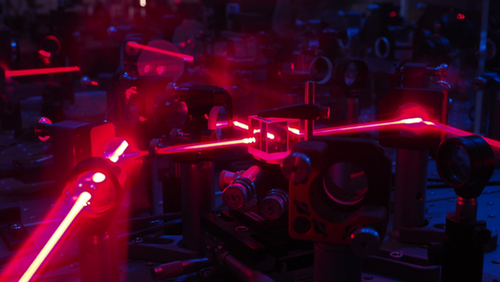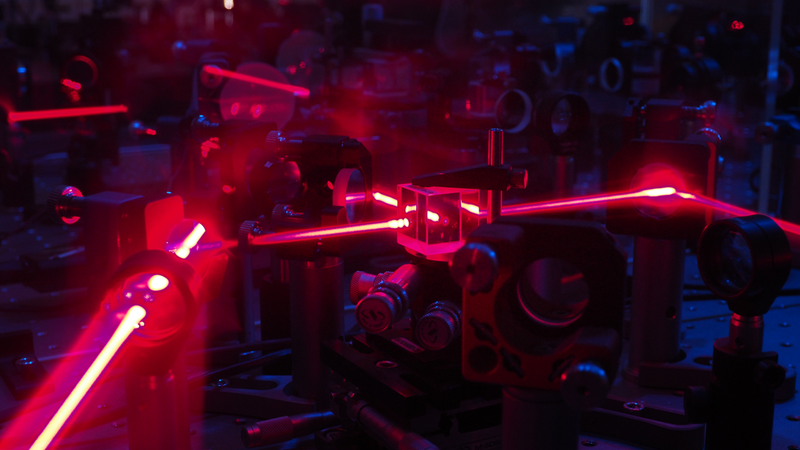Computer Chooses Quantum Experiments
The notoriously counterintuitive features of quantum mechanics make it hard to design experiments to study the quantum fundamentals and to develop quantum computing and quantum cryptography. So a team of researchers has developed an algorithm for combining the building blocks of quantum optics experiments, such as beam splitters and mirrors, to achieve a particular goal, such as a certain photonic quantum state. The experimental arrangements generated so far are ones the researchers say they were unlikely to have thought of themselves, and some work in ways that are hard to understand.
Experiments in quantum optics, whether for fundamental or practical ends, tend to use a rather limited set of components to manipulate the quantum states of photons. Beam splitters can send laser light along two different paths with certain probabilities and generate so-called superposition states in which photons seem to take two paths at once. Nonlinear crystals generate pairs of quantum-connected (entangled) photons, and the usual mirrors and lenses guide laser beams.
The algorithm designed by Anton Zeilinger of the University of Vienna and his co-workers, called Melvin, takes elements like these and shuffles them to find an experimental arrangement that will produce specified quantum properties in the photon beams. For example, many experiments require entanglement, where two photons have some property, such as polarization or angular momentum, that is correlated—measuring the value for one photon tells you the value for the other. Researchers might also want to manipulate single photons.
Melvin begins by arranging the elements randomly; it then calculates the resulting photon beams and checks whether any of them comes close to the specified goals. If not, the process is repeated. But if the output meets the design criteria, Melvin then does some further shuffling to simplify the setup before reporting it to the user. The algorithm can also learn from experience, remembering certain configurations that achieve particular goals, so that it can build on them in the future.
Doctoral student Mario Krenn came up with the idea of automating the design process when he found himself struggling to devise a way of creating a particular kind of quantum state. He realized that he was just guessing—and that a computer could do it much faster. “So I defined the goal, made an algorithm, and let it run overnight,” he says. “In the morning there was indeed a ‘solution.txt’ file. That was quite an exciting day.”
The Vienna team has demonstrated their method using so-called Greenberger-Horne-Zeilinger (GHZ) states, in which more than two photons are entangled. When the entanglement involves more than one of the particles’ variables—multiple components of orbital angular momentum, say—they are said to be high-dimensional and can be challenging to produce. Melvin delivered 51 different experiments that could realize entangled states using combinations of various optical elements, and one of the states was the high-dimensional GHZ state they were seeking.
Quantum theory verifies that Melvin’s arrangements should work, but that doesn’t mean it's easy to understand why. “I still find it quite difficult to understand intuitively what exactly is going on,” Krenn says. Such a lack of understanding, even for experiments with only a few components, “is unique to quantum physics,” says Krenn.
What’s more, the setups look rather different from what a human might try. All but one of them include a photon path that, after being initially entangled, doesn’t interact with any other beam path before it reaches the detector. The researchers are now seeking to test these predictions experimentally and have already managed to create the multiphoton, high-dimensional entangled state [1].
In a second proof of principle, Melvin found several sequences of operations that were cyclic—they could transform photon properties through a series of changes that end up back with the initial state. And these transformations were also high-dimensional. Such sequences could be useful in quantum computing or cryptography.
“This is an original and unusual paper,” says quantum physicist Nicolas Gisin of the University of Geneva. But he thinks automation of experimental design will only augment, not replace, human agency in the foreseeable future. Quantum physicist Terry Rudolph of Imperial College in London says that the work “has the potential to uncover new tensions between quantum and classical descriptions of the world.” He expects few of Melvin’s solutions to be understandable once it gets past the simplest combinations of experimental elements.
This research is published in Physical Review Letters.
–Philip Ball
Philip Ball is a freelance science writer in London. His latest book is How Life Works (Picador, 2024).
References
- M. Malik, M. Erhard, M. Huber, M. Krenn, R. Fickler, and A. Zeilinger, “Multi-Photon Entanglement in High Dimensions,” Nature Photon. advance online publication (2016).





